|
This
internet site is a non political one, this article will only
focus on the gear used in the Israeli Airforce and not why it
was used.
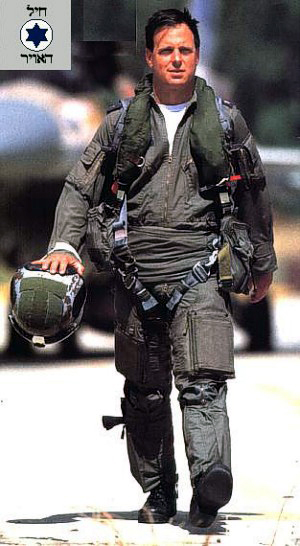
As a
combat proven airforce, the Heyl Ha’Avir (Israelian Airforce)
has some of the most experienced pilots in its ranks. But the
constant state of alert, also makes it almost impossible to get
a decent picture of an Israelian pilot. The information on this
site does not claim to be correct but will give an idea of the
flight gear used. For some video footage, i would recommend the
Iron Eagle series (!) not for the story, but original Israelian
flight gear was used while filming from Ramat David airbase.
The IAF has a different attitude to flight-crew clothing
compared to other airforces. Although the crew all proudly wear
their squadron/aircraft patches, there is a total lack of rank
or occupational insignia. Dictated by combat experience, you are
unable to tell the difference between, a colonel pilot and a
sergeant flight-engineer. No stars, bars or wings are worn.
The 1950’s
In the early years of their existence, the Israelian Airforce
depended heavily on aircraft like the Spitfire, Mosquito and
Meteor. As these were British build planes, the flight gear also
came from the same source. Early jet jocks and prop drivers were
probably wearing C type leather flight helmets with H type
masks. Also some USAF type masks and helmets were noted. The
lifejackets used ranged from the old Mae West types (early
50’s) and USAAF B-4’s to the (late 50’s) Jacket,
life-saving Mk4(A)’s. This orange life vest contained a radio
and emergency light.
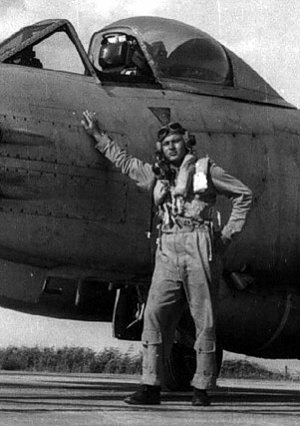
During
the following years the Israelian Airforce recieved some French
build airplanes. Among them the Mystere IV and Vautour. The
flight gear however was bought from the USA. The pilots used a
range of P-series helmets. From the visorless P-1 to the later
P-3 and P-4 types. With this helmet a new oxygen mask was worn,
this time the MS22001. The life jacket did not change although
the pilots used to wear a B-4 with the P-1 helmet. These were
the days of the war with Egypt (Operation "Kadesh") in
wich numerous combat flights were made. The IAF first used jet
powered planes in the Sinai War. About 50 jets were deployed,
alongside a similar number of piston engines planes. Seven
Egyptian jets were shot down in dogfights during the war. The
IAF lost 15 planes in the fighting.
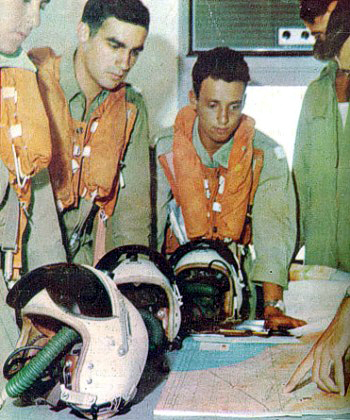
The
1960’s
The sixties started were the fifties ended, the flight gear did
not change much and Israel stayed on high alert. New planes were
taken on charge like the Super Mystere and Mirage III. In 1967
Israel started the 6 Day War with an assault on the airfields of
its neighbours. In the Six Day War the air force changed all air
power doctrine when it destroyed three Arab air forces in a few
hours. New helmets were used while flying. Film footage from
these days show Heyl Ha’Avir pilots wearing white HGU-2A/P
helmets, of the single visor type, with leather oxygen mask tabs
(like the P-series). The oxygen mask remained the MS22001. With
this helmet and mask, a kakhi colored coverall was worn. The
g-suit seemed to be of the Z-3 or CSU-3B/P type. Footage from
these days also show a green flight helmet that appears to be an
HGU-2A/P but might be an APH-5 also.
The 1970’s
This was the decade of the October War or Jom Kippoer War. The
Israelian Airforce flew the F-4 Phantom, Mirage IIIC and A-4
Skyhawk but had some considerable losses in the first days.
Pilots flying the Phantom and Mirage were wearing the HGU-22/P
shell or HGU-2/P helmet with a single visor assembly. The
MS22001 mask was attached with bayonets and cast recievers to
the helmet. The A-4 Skyhawk pilots had slightly different gear.
The torso harnass was of the MA-2 full body type and the helmet
appeared to be an APH-5 with a one piece ramshorn dual visor
setup. The mask was attached with snaps to leather tabs inside
the helmet.
The 1980’s to present
New planes in a new decade, F-16’s and F-15’s now dominate
the skies over Israel.
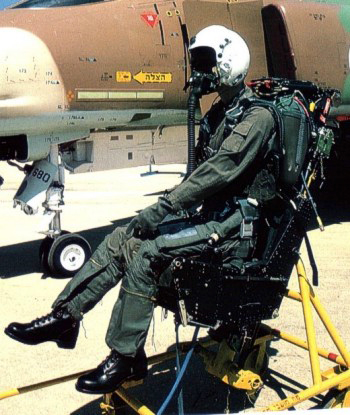
Pilots
and aircrew continue to wear the HGU-22/P and HGU-2/P helmet
assemblies. Only this time most of the helmets are covered with
a felt like material. It is not clear which helmet is of the HGU
type or the Israelian made ULH (Ultra Light Protective Helmet)
series as they all are worked on to the same specifications.
Sometimes the entire helmet is covered or large pieces are
applied to it. The visor housing is cut to give it a
“gullwing” appearance like the EEK-4A/P visor housing. This
combined with the thick leather edge roll (PRK-37 or Scott
snap-on type) gave some sources the idea the helmet was of the
HGU-33 family. There is no evidence what so ever that the helmet
is the so called HGU-34HA. The position of the communications
cord in the helmet and some other aspects, clearly identify the
helmets of being an HGU-22/P shell, HGU-2/P or ULH helmet. The
helmet can be white or painted gray, most of the time the holes
for the ear cup laces are still in place.
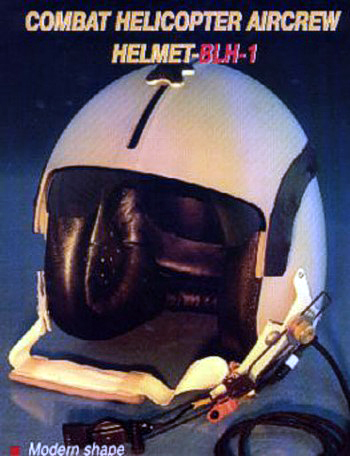
Some
housings are covered in felt, others in black leather. The
oxygen receivers are of the cast type or the lightweight ones. A
lot of different variations on the theme seem to appear. No
helmet looks the same and all are fitted with white chinstraps.
The IAF closely follow the HGU-22/P TO while performing upgrades
and modifications. Even the lightweight modification is seen.
The HGU-22/P or ULH shell is fitted with a single bungee style
visor and visor stops. The oxygen receivers are also lightweight
and the helmet gives an overall impression of an HGU-55/P.
The manufacturer of the ULH and BLH helmets is not know but the
Israelian TAMA firm made some HGU-55/P look a likes for the
Belgian Air force. These helmets (the shells) have been produced
from "KEVLAR 49" with "EPOXY" matrix by
using "Pressure Bag Molding System". The R&D, and
the complete production line were constructed by Tama and is a
specific Tama's know-how. The visor and other component are
bought from the USA. These shells appeared to be of inferior
quality and tend to break as they were made from two pieces.
Production stopped in the early nineties.
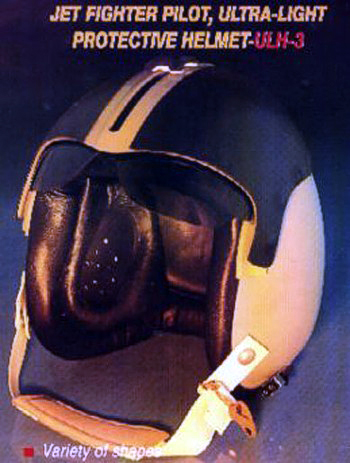
The HGU-55/P is also used like the one from Amer Nave, he is an
ace and ranked third in the IAF. His HGU-55/P is customized with
dark blue paint with small white stars. The leather parts on the
helmet are finished in black. Masks used are the MBU-5/P,
MBU-12/P and the MS22001 (MBU-3/P) they all appear with J and T
type bayonets.
Depending on the type of aircraft a PCU type torso harness is
worn, on the Ahit (A-4 Skyhawk) however this is the later type
MA-2. G-suits are of the CSU-3/P and CSU-13/P type. The life
preserver that is combined with the PCU is the LPU-17/P.
In 1984 Elbit Systems of Israel started the work on the DASH
helmet (Display And Sight Helmet). This helmet is now known as
the DASH Generation I Mk.222A and based upon the HGU-22/P helmet
shell. In 1988, Elbit made the DASH Generation III prototype
which saw production in 1989. From this design several slightly
different models were made, depending on the aircraft it was
mend for. The DASH III helmet is based on the HGU-55/P helmet
shell.
The DASH is fully operational on the major Israeli fighters and
is also used on the Ya’sur 2000 CH-53. The pilots in the CH-53
use the miniaturized HUD display inside the eyepiece of the
pilot’s helmet, to show the most essential flight data, such
as altitude and speed. On the fighters, the helmet is linked to
the Phython air to air missile.
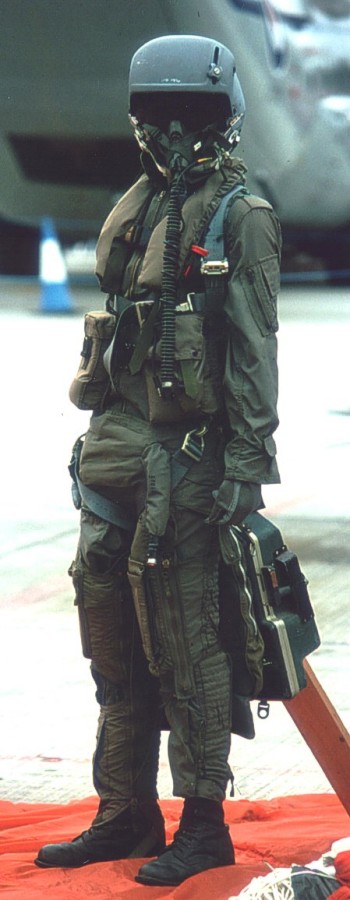
Other
helmet types
Some planes or tasks ask for specific helmet types and
equipment. The AH-1 Cobra helicopter pilots for instance are
equipped with SPH-3 helmets with helmet mounted sights attached.
The Hughes 500 helicopters are equipped with nearly the same
armament as the Cobra but the pilots are wearing a totally
different helmet. The helmet appears to be an HGU-22/P shell or
Israelian BLH-1 (Combat Helicopter Aircrew Helmet) painted
brown/green with a visor housing that includes a sighting
system.
This
helmet without the sighting system is seen as a single visor
version with other helicopter pilots like the ones on the UH-60
and SA365 helicopters. Apache pilots are wearing the IHADSS
integrated helmet sighting systems that is considered a part of
the helicopter.
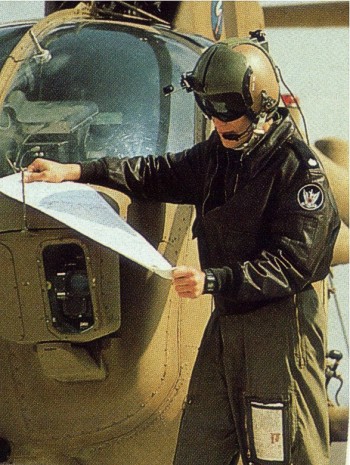
For
night flying, the helicopter helmets can be equipped with the
ANVIS 6 type night vision goggles. These are mounted with a
large bracket that clamps over the visor housing. For fighter
pilots, video footage shows a helmet with a single visor cover
with an off center visor track. This allows the mounting of a
NVG device on the helmet.
NBC threats are countered with a MBU-13/P full face mask worn
together with a NBC protective coverall. The helmet is not know
but might be of the HGU-39/P type.
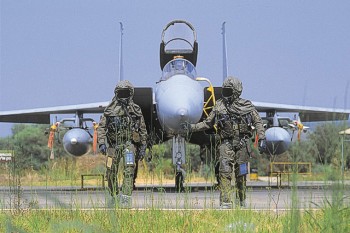
Special
thanks to Christian Brydges for his image of the Israelian pilot
with DASH helmet, Ms. Elizabeth Harosh from TAMA Plastic
Industry and the Israelian Airforce for their help. |